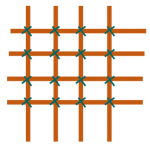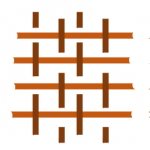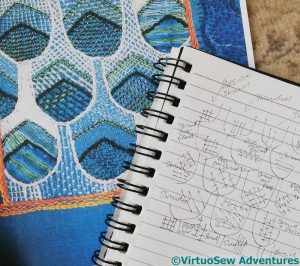Nefertiti Shawl – an excursion into duality
Having completed one green panel, I decided that I wanted the other green panel to be not quite the same, and I couldn’t work out how to approach keeping the family resemblance and maintaining some sense of balance.
So I asked The Australian, who you may remember is also a mathematician. He looked at me in some perplexity for a while. In fact, as I explained the layers of patterns I’d created, he eyed me more than a little askance, and then went very quiet for a while (you’d think he’d be used to it by now…).
Finally, he suggested I think about duality. Now, this isn’t a philosphical thing – it’s quite tightly defined, in the geometrical sense, at least – see this Wikipedia page – so after some discussion over lunch, we decided that if I were to regard the elements of the two green panels as duals of one another, it would give me a systematic way to approach the second one, rather than flailing around randomly.
Now I had to decide what was what’s dual….
For example, in the first panel, I chose between floss silk or stranded silk, and in the case of stranded, between solid colour and variegated; then in terms of stitch orientation (going clockwise), between vertical, diagonal, horizontal and the other diagonal. In this context, I’m not sticking to the idea of a binary choice, so for example with stitch orientation I will go to the next 45degree angle around the clock face, while with the thread, I’m going to pick some ordering of variegated stranded, plain stranded and variegated floss and then move along to the next in that sequence.

In terms of the stitch choice, essentially there are four: Jacobean trellis, darning stitch (rows of irregular running stitch, in effect), Bokhara couching, and Woven Stitch.

I can choose to make Bokhara Couching and darning stitch each other’s duals – that will move the heaviest stitching to different places in the panel.
The other two will be each other’s duals, with the added complication that they have each involved two different threads.
Have I simplified my life or complicated it?


I think this is either complifying, or simplicating! You have narrowed down your stitch and thread options, restricted your palette and used the previous panel as a guide to what works and the degree of balance needed among the available ingredients. You can now go forward confident that it will all work out in the end. (While having a convenient Australian to blame if it doesn’t.)
🙂 I have no idea! It sounds like a good idea to me, and I hope it simplifies your approach.
I am totally confused but then, I am not the one trying to solve this particular problem. I have a theoretical physicist on tap. Well, that’s what he did for his MSc. Now he designs and writes software. He has also been known to do a bit of embroidery. He’s my go to person if I simply cannot work out how to do a particular stitch. Very handy. Big thank you to all mathematical practitioners. You rock!
Good luck working out your particular conundrum, Rachel.
Actually that is a very good solution to your problem. I know it sounds complicated but it is really very logical. (My husband is and Engineer and he agrees.
Sounds very complicated to me! xx
Great solution!
With all the difficulties you are going through with this project, you seem to have a done a pretty good job on this shawl. Happy stitching! keep up your good work!
I absolutely love how you go about this Rachel!
Good luck!
It is complicated, but it simplifies your choices because it narrows the options. =)